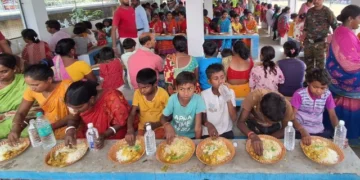In the aftermath of the recent communal violence that has rocked parts of Bengal, many families are grappling with a harsh reality: they have been displaced from their homes and may never be able to return. The violence, which erupted in several districts, has left behind a trail of devastation, causing both physical and emotional scars that will take years to heal. As communities grapple with the effects of the violence, one theme resonates deeply with the displaced victims: a deep sense of alienation and a loss of identity in their own land.
For many families who fled the violence, the prospect of returning home is becoming increasingly bleak. Once vibrant neighborhoods, now reduced to ashes, symbolize a loss of not just property, but also a sense of belonging. “We are refugees in our own land,” said one survivor, a mother of two children who was forced to leave her home after a mob attacked her locality. “The violence has torn apart our lives, and now we have nowhere to go. This is no longer home. We may never return.”
These words reflect the growing fear among the displaced. What was once a place of security has turned into a battleground, with families having to abandon everything they held dear. Local markets, schools, and homes have all become casualties of this violence. Some have sought shelter in neighboring areas, while others are being housed in relief camps with little hope for a brighter future.

The communal violence in Bengal appears to have deep roots in longstanding political and religious tensions. Although the immediate triggers may vary, experts argue that the violence is often fueled by divisive rhetoric, deep-seated prejudices, and political exploitation. Communities that once coexisted in harmony are now torn apart, as fears of retribution, retaliation, and further violence keep everyone on edge.
The ongoing violence is not a new phenomenon. It has been simmering for years, with sporadic flare-ups that are exacerbated by political clashes. But what sets this wave of violence apart is its sheer scale and intensity, leaving entire families displaced and in despair.
The victims of Bengal’s communal violence face not just physical displacement but also emotional trauma. Many survivors feel that they have been abandoned by the authorities, with their cries for justice ignored or dismissed. As they seek refuge in relief camps or temporary shelters, there is little clarity on what their future holds.Bengal
Human rights organizations have condemned the violence, calling for urgent measures to restore peace and security in the affected areas. However, the victims themselves often feel forgotten, as their stories of suffering are overshadowed by political discourse and media sensationalism.
“We don’t want to be remembered as victims of communal violence,” says another displaced individual, a teacher who fled with his family. “We want justice, but more importantly, we want to return to our homes, rebuild our lives, and live in peace. Right now, that seems impossible.”
For the families affected by the communal violence, the future is uncertain. Many have lost their livelihoods and are now left to rebuild their lives from scratch. Their once-thriving businesses and homes are now ruins, and they are left to navigate the challenges of living as refugees in their own homeland.Bengal
With no end in sight, and no clear path for return, the displaced citizens of Bengal are facing a grim reality. While they remain hopeful that peace will one day return, the road to recovery seems long and fraught with uncertainty. For many, the question remains: When will we be able to go back home?
In the wake of this violence, one thing is certain: the residents of Bengal are living through a dark chapter in the state’s history, and their struggle for justice, peace, and a return to normalcy continues to resonate with millions of displaced families. They are refugees in their own land, hoping against hope that one day, they will be able to call it home again.















 Categories
Categories










